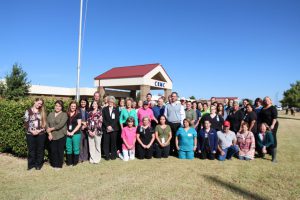Contents
Childress Regional Medical Center Shows Safety Pays
OSHA considers workplace violence standard for healthcare
OSHA under Trump: A closer look
Childress Regional Medical Center Shows Safety Pays
Childress Regional Medical Center is one of the great success stories of the HOTCOMP Safety Group. The hospital’s CEO, John Henderson serves on both the HOTCOMP Board and the HOTCOMP Safety Committee. The hospital’s Human Resources Manager, Gayle Cannon, also serves on the HOTCOMP Safety Committee. We chatted with Mr. Henderson and Ms. Cannon about how making safety a priority has paid off.

Photo Credit: Childress Regional Medical Center
Safety Pays
Childress joined HOTCOMP in late 2007. Mr. Henderson recalled, “At that time we had not had bad years with a lot of claims or losses, but our premiums were trending up.” Since joining the program Childress has seen, on average, a steady decrease in premium over the years. In April 2016, Childress renewed their participation with HOTCOMP. “At that time we received a premium that was half of what our premiums were when we started with HOTCOMP.” Mr. Henderson stated.
Due to their participation in HOTCOMP Childress receives two dividends: the Texas Mutual loyalty dividend and the HOTCOMP Safety Group dividend. In August 2016, Childress received both of these dividend checks from Texas Mutual. “Receiving those checks was a bit of a shock this year.” Mr. Henderson explained. “Together the loyalty dividend and the dividend from the safety group nearly paid our entire premium. We really appreciate that Texas Mutual rewards our hospital for loyalty and, as a hospital safety group member, for having a successful safety program.” The success Childress has had with the program shows safety pays in a variety of ways.
A Safety Culture from the TOP Down
HOTCOMP Safety Committee Administrator, Barry Couch, commented, “One thing that has been obvious working with Childress through the years is their safety culture starts from the top. Safety is a huge priority for John Henderson and that shows in the low incident rates with the hospital’s employees.”
HOTCOMP talked with Ms. Cannon, who helps lead the hospital’s safety program, about how the program works. One of the first things she mentioned was the hospital’s “environment of ownership of actions that is taught to the employees; not in a disciplinary fashion, but rather ‘what can we do to improve process to avoid future incidents?’” When incidents do occur, there is an initial report. In that report, the employee gives the specific details of the injury and how it occurred. Then, the employee is assessed by a Registered Nurse and, if necessary, is referred to a Nurse Practitioner or Physician for further evaluation. The hospital also holds quarterly safety committee meetings to review employee incidents for further evaluation of procedures. Additional subcommittee meetings, consisting of the safety officer, safety secretary, and the department manager of the employee, is held if an employee has two or more of the same incident in a 12 month period. “Again, the focus of the meetings is not disciplinary in nature, but exploratory. The purpose is to find out what we need to do improve what we do.” Ms. Cannon explained.
Like most hospitals, back strains are a challenge for Childress. “Our number one employee safety challenge is one-on-one patient assists. Our employees feel they need to respond immediately to an issue, when in reality they should wait for help from a co-worker.” Ms. Cannon stated. If the injury is a back strain the incident goes before a subcommittee of the department head, safety secretary, and safety officer. The subcommittee reports back to the employee and procedures are changed if necessary. Taking the time to evaluate these specific safety challenges shows employees that the hospital is invested in their safety
The hospital also invested money on safety equipment, designed to specially address patient handling injuries. They purchased and installed patient bariatric ceiling lifts for two rooms as well as an ambulance bariatric power lift. The safety committee created policies to incorporate the equipment, had employees review and sign the new procedures, then continued to educate through ongoing demonstrations on how to use the equipment. “Since installing the lifts our employee incidents have gone down tremendously,”Ms. Cannon stated.
Sharing what works
Childress hospital makes safety a priority, and those efforts keep employees’ safe, incidents low, and costs down. They help make HOTCOMP a successful program by having Mr. Henderson and Ms. Cannon serve on the safety committee. “Their participation in committee meetings adds tremendous value to HOTCOMP. They not only invest time and money in their hospital’s successful safety program, but they also want to help other hospitals have successful safety programs.” Said Mr. Couch. “They are a feather in HOTCOMP’s hat.”
We want to hear from you. Please share your safety challenges and success stories with us.
OSHA considers workplace violence standard for healthcare
On December 7, the Occupational Safety and Health Administration published a Request for Information (RFI) to solicit information on a potential standard to prevent workplace violence in healthcare and social assistance settings. The RFI also solicits more detailed information on topics such as effective strategies for reducing incidents of violence in various healthcare and social assistance settings. Comments and materials may be submitted electronically to www.regulations.gov, the Federal eRulemaking Portal, or via mail, facsimile or hand delivery. Read the Request for Information for submission details. The submission deadline is April 6, 2017.
OSHA held a public meeting on Jan. 10 for interested parties to comment on the need for a standard to prevent workplace violence in healthcare and social assistance. This meeting was intended to supplement written comments by allowing workers to tell of their personal experiences with workplace violence as well as allowing for discussion among stakeholders.
OSHA under Trump: A closer look
Legal experts are predicting significant changes for worker safety regulation under the new administration
Safety and Health Magazine by Tom Musick
A new presidential administration almost certainly will mean a new direction for OSHA, legal experts agree. Regulations could be undone. Funding could decrease. Strategies for worker safety could shift 180 degrees.
How soon will changes arrive? Which objectives will take priority? Who will next be chosen to lead OSHA? Those decisions ultimately lie with President Donald Trump and his team as they settle into the White House.
“Even if it wasn’t Trump, just having a Republican in office would have been a substantial change by itself,” said Mark Kittaka, a partner and administrator of the Labor and Employment Law Department at Barnes & Thornburg LLP in Fort Wayne, IN. “Because it’s Trump, it’s going to be even more. It definitely will change.”
On the campaign trail, Trump touted his belief in smaller government with fewer rules and more freedoms. He vowed to eliminate two regulations for every new one enacted. He promised to ease the burdens on big businesses and blue-collar workers alike by stimulating the economy and creating jobs.
Workplace safety did not take center stage as a campaign issue for Trump or any other presidential candidate. But Trump’s limited-regulation stance, coupled with his experience in construction and other industries, suggest to some that he will steer OSHA more toward compliance assistance and away from enforcement. ![]()
Under OSHA’s recordkeeping regulation, certain covered employers are required to prepare and maintain records of serious occupational injuries and illnesses using the OSHA 300 Log. This information is important for employers, workers and OSHA in evaluating the safety of a workplace, understanding industry hazards, and implementing worker protections to reduce and eliminate hazards.
However, there are two classes of employers that are partially exempt from routinely keeping injury and illness records. First, employers with ten or fewer employees at all times during the previous calendar year are exempt from routinely keeping OSHA injury and illness records. OSHA’s revised recordkeeping regulation maintains this exemption.
Second, establishments in certain low-hazard industries are also partially exempt from routinely keeping OSHA injury and illness records. Due to changes in OSHA’s recordkeeping requirements that went into effect Jan. 1, 2015, certain previously exempt industries are now covered. See the lists of both exempt and newly covered industries for details.
The previous list of partially exempt industries was based on the old Standard Industrial Classification (SIC) system and injury and illness data from the Bureau of Labor Statistics (BLS) from 1996, 1997, and 1998. The new list of partially exempt industries in the updated rule (link) is based on the North American Industry Classification System (NAICS) and injury and illness data from the Bureau of Labor Statistics (BLS) from 2007, 2008, and 2009. Click here for more information.
|
Barry Couch, CEO
Program Administrator
|
Linda Rasor, CEO
Castro County Hospital |
|
John Henderson, CEO
Childress Hospital |
Gayle Cannon, Director of HR
Childress Hospital |
|
Chuck Norris, CEO
Gonzales Healthcare |
Carol Villareal, HR Manager
Gonzales Healthcare |
|
Emily Dossey, COO
Hamilton General Hospital |
Marcy Murrell, Co-Safety Director/Infection Control Nurse
Sweeney Hospital
|
About Safety Matters:
It is our hope that this publication, in addition to Texas Mutual’s Safety Resource Center, proves a useful tool to promote safety in our members’ hospitals. The newsletter will focus on safety issues that specifically trend to our membership hospitals.
We hope to hear from you on safety issues your hospital is facing and on successful safety procedures you have implemented. It is the safety committee’s goal to create a collaborative exchange of ideas that contributes to making all of our hospitals safer which, in turn, will increase our safety group’s benefits.
Please send your ideas, questions and comments to safety@hotcomp.net.
Why Your Safety Matters:
You’re receiving this email as a member of the HOTComp safety group. The group is a joint effort between HealthSure and Texas Mutual Insurance Company.
Group members receive exclusive benefits like targeted safety resources, a discount on their workers’ compensation insurance and potential dividends based upon the safe performance of the group. HOTComp group participants have shared in over $1 million in group dividends since 2008 in addition to individual dividends from Texas Mutual.

